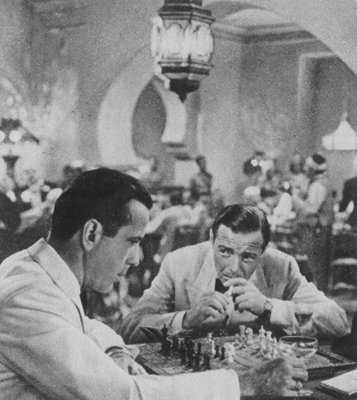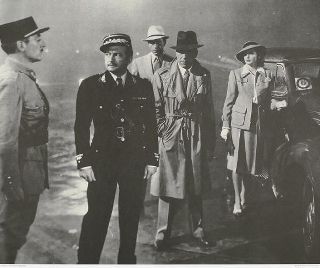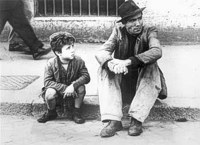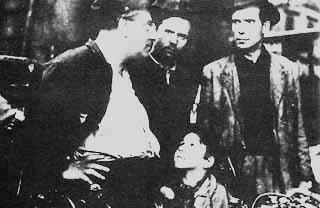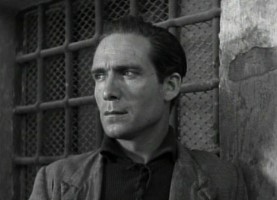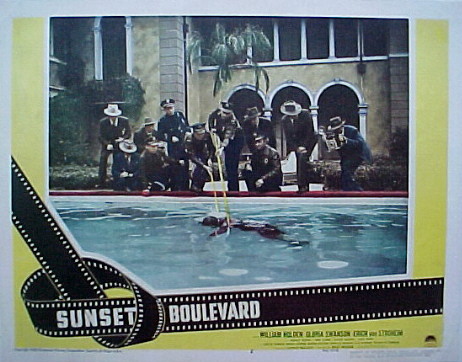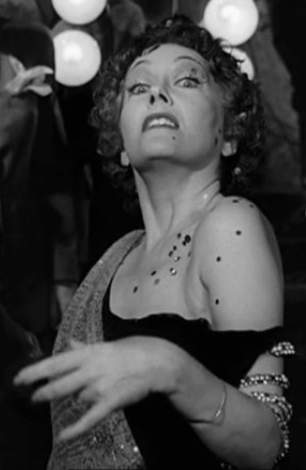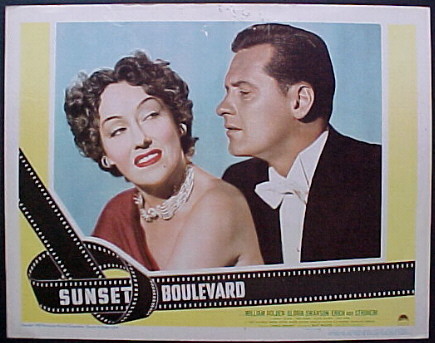 | In Black and White (1940-1950)- Film Noir and Italian Neorealism |
|
Casablanca |
|
|
|
The Bicycle Thief |
|
Vittorio De Sica |
|
Sunset Blvd (1950) |
|
Billy Wilder''s Film-Noir Classic |
Casablanca, Burbank L.A. - Michael Curtiz (WB)
Casablanca is a simple love story about two people who loved each other and are then reunited when their lives have become more complicated. The setting and historical (second war time)background give it an epic feel, but it is all about human emotions and memories. Mostly it is about love.
Webster''s Dictionary - neorealism: a movement especially in Italian filmmaking characterized by the simple direct depiction of lower-class life.
To elaborate: "Neorealist films are characterized by a pronounced social consciousness on the part of their makers, a concern for the lower classes and their despair and squalor, and a stark realism of technique relying heavily on long takes and depth of field" - from A Viewers Guide to Film Theory and Criticism by Robert T. Eberwien.
The Bicycle Thief (italy, 1947) - won a special Academy Award in 1947 for its stark portrayal of post-World War II Italy. Acclaimed as the epitome of Italian neorealism, the heart of the film is the bond between a father and son. To assay this crucial relationship, director Vittorio De Sica cast two non-professionals. Before-and after-playing the lead, Lamberto Maggiorani was a steel factory worker. Similarly, De Sica plucked his "son," Enzo Staiola, from a crowd of people watching production on the film.
Antonio Ricci (Maggiorani) is an out-of-work husband and father. His fortunes seem to change when he is singled out from an unemployment line and given a job putting up posters. The only hitch is that he needs a bicycle to perform the job. His wife Maria (Lianella Carell) pawns their bed sheets to buy a bike, which is stolen on his first day of work. The remainder of the film focuses on the plight of Antonio and Bruno (Staiola) as they search throughout Rome for the bicycle.
The film is a potent metaphor for postwar Italy. Antonio turns to the traditional power structures-political leaders, the Church, and the police - looking for relief but finding none. Eventually he consults with a self-styled soothsayer whose answer prompts him to take matters into his own hands. In his frantic quest, Antonio nearly alienates his doting son. But ultimately, their relationship is the factor that prevents him from the fate he deserves. In the midst of hopelessness, a simple act of mercy proves to be a literal saving grace for Antonio.
Sunset Blvd. - film noir - Genre of noir: http://www.imagesjournal.com/issue02/infocus/filmnoir.htm.
Film Noir: An Introduction
Dark rooms with light slicing through venetian blinds, alleys cluttered with garbage, abandoned warehouses where dust hangs in the air, rain-slickened streets with water still running in the gutters, dark detective offices overlooking busy streets: this is the stuff of film noir--that most magnificent of film forms--a perfect blend of form and content, where the desperation and hopelessness of the situations is reflected in the visual style, which drenches the world in shadows and only occasional bursts of sunlight. Film noir, occasionally acerbic, usually cynical, and often enthralling, gave us characters trying to elude some mysterious past that continues to haunt them, hunting them down with a fatalism that taunts and teases before delivering the final, definitive blow. Unlike other forms of cinema, the film noir has no paraphernalia that it can truly call its own. Unlike the western, with cattle drives, lonely towns on the prairie, homesteading farmers, Winchester rifles, and Colt 45s, the film noir borrows its paraphernalia from other forms, usually from the crime and detective genres, but often overlapping into thrillers, horror, and even science fiction.The visual style echoes German expressionism, painting shafts of light that temporarily illuminate small chunks of an ominous and overbearing universe that limits a person''s chances to slim and none. For as Paul Schrader said in his influential "Notes on Film Noir" essay, "No character can speak authoritatively from a space which is continually being cut into ribbons of light."
Heroes in the film noir world would forever struggle to survive. Some of the heroes learned to play by the rules of film noir and survived by exposing corruption, such as Humphrey Bogart in The Big Sleep and Dick Powell in Murder, My Sweet. But more often than not, they were the saps destroyed by love (Fred MacMurray in Double Indemnity and Edward G. Robinson in Scarlet Street), a past transgression (Robert Mitchum in Out of the Past), or overly ambitious goals.
Slide show from Sunset Blvd. - http://www.imdb.com/gallery/mptv/1196/5378_0133.jpg.html?path=gallery&path_key=0043014&seq=8
Italy
1.The Italy Cinema Before Neorealism
a.Italian Cinema before the Fascists 1914- 1930 (American -style romantic comedias)
b.A former Marxist, Mussolini and his cinema era (he was particularly impressed by Soviet achievement in blending film and politics and thinks about cinema like Lenin "the strongest weapon " of the age). He reorganized the Italian industry along Soviet lines.In 1924 Mussoliny founded LUCE to produce news about his regime, 1935 - ENIC to control filn industry and film school system "Centro Sperimentale..." (CSDS) like in USSR.
3. The Centro Sperimentale, under under the directions of Luigi Chiarini (1900-1975), a covert Marxist, had such students as Roberto Rossellini, Luigi Zampa, Pietro Germi, Giusette De Santis, Michelangelo Antonioni. They has own theoretical journal, "Bianco e nero", and "Cinema" , there were translations of Eisenstein, Pudovkin, and Luchino Visconti. Calligraphism - a sort of decorative, pictoral formalism that manifested itself in meticulously photographed adaptations in 60s fiction, like Luigi Chiarini''''s Via delle Cingue Lune (Five Moons Street, 1941) and ets.
Middle class comedy Alessandro Blasetty and Vittorio De Sica, and Marxist screenwriter Cesaro Zavittini.
The Foundations of Neorealism.
1.Zavattini was the theoretical founder of neorealism. -"everyday life": "The reality buring under the myths slowlyreflowered. The cinema began its creation of the world. Here was a tree; her, an old men; here, a house; here, a man eating, a man sleeping, a man crying... The cinema...schould accept, unconditionally, what is contemporary. Today, today, today."
2.Umberto Barbaro''''s (1902-59) popularised realistoc national cinema like a "new realism" and Soviet expressive realism of Eisenstein, Pudovkin, and Dovzhenko like ideology.
3. French poetic realism that espoused a kind of socialist humanism that Italians found at least as appealing as the strident Soviet Marxism.
4. Luchino Visconti''''s grim tale of passion and murder in modern Italy. film "Ossessione" 1943 that was based on the poetic triller "The Postman Always Rings Twice" by the American novelist James M.Cain - melodramatic plot and brutal characters.
Neorealism: Major Figures And Films.
1. Rosellini''''s film "Roma,citta aperta" 1945 - a remarkable film of Italian resistance.
2. Another Rosellini''''s films.
3.Vittorio De Sica (1901-74)
4."La terra trema" - (Luchino Viscinti(1906-76).
5.Realism as a style, as camera movements, rhythmic editing, composition. Cinema verite, and the tension between visual lushness and social realism.
5. Pietro Germi (1914-74)
The Decline of Neorealism: Pessimistic. Afte War it lost its ideological basis.
The Impact of Neorealism
Neorealism revitalized Italian film so that today it has become of the major creative forces in world sinema , and provided training for two greatest artists - Federico Fellini (1920-93) and Michelangelo Antonioni (1912).
Casablanca 1942
40th
SUNSET BLVD (1950)
The Bicycle Thief
Italian Neorealsim

